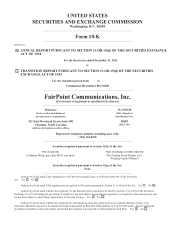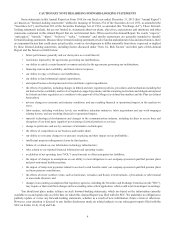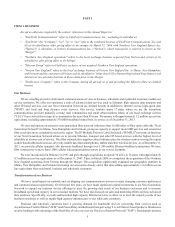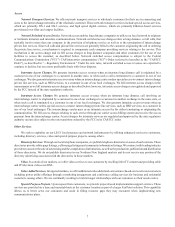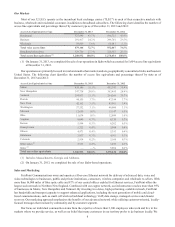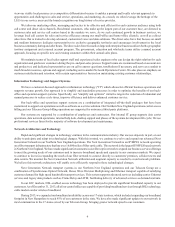FairPoint Communications 2013 Annual Report Download - page 12
Download and view the complete annual report
Please find page 12 of the 2013 FairPoint Communications annual report below. You can navigate through the pages in the report by either clicking on the pages listed below, or by using the keyword search tool below to find specific information within the annual report.10
Our LEC network consists of 93 host central offices and 412 remote central offices, all with digital switches. Approximately
99% of our central offices are served by fiber optic facilities, which we own. The primary interconnection with other incumbent
carriers is also fiber optic. Our outside plant consists of both fiber optic and copper distribution networks.
Competition
The telecommunications industry is comprised of companies involved in the transmission of voice, data and video
communications over various media and through various types of technologies. The competitive environment continues to intensify
as consumers and businesses are provided more options for a variety of services, pricing and service quality. Presently, there are
four predominant types of local telephone service providers, or carriers, in the telecommunications industry: ILECs, CLECs, cable
companies and wireless carriers. ILECs, which the majority of our 32 LECs operate as, were the traditional monopoly providers
of the local telephone service prior to the passage of the Telecommunications Act of 1996 (the "1996 Act"). A CLEC is a competitor
to local telephone companies that has been granted permission by a state regulatory commission to offer local telephone service
in an area already served by an ILEC. CLECs typically offer voice and data services to their customers. Cable companies are
the traditional video distribution providers in the market and are now selling packages of voice and data services along with their
video services. Wireless competitors also have a significant presence in most markets, offering local and long distance voice
services, along with mobile data offerings. As a result, competition in local exchange service areas for voice and data services has
increased and is expected to continue to increase from these competitors.
Overall, we face intense competition from a variety of sources for our voice and data services in most of the areas we now
serve, many of whom have greater resources and access to capital, and we expect that such competition will continue to intensify
in the future. This competition has had an adverse impact on our access lines, broadband subscriber growth rates and revenues.
Regulations and technology change quickly in the communications industry, and these changes have historically had, and
are expected to continue in the future to have, a significant impact on competitive dynamics. For instance, the ubiquity of wireless
networks coupled with technology changes, such as VoIP and data-driven devices (i.e., smartphones and computer tablets), are
creating increased competition and technology substitution, a trend we expect will continue for the foreseeable future. Public
monies in the form of stimulus funds to build broadband networks are also providing a new source of competition for us. In addition,
many of our competitors have access to larger workforces or have substantially greater name-brand recognition and financial,
technological and other resources than we do. Moreover, some of our competitors, including wireline, wireless and cable, have
formed and may continue to form strategic alliances to offer bundled services in our service areas.
We estimate that, as of December 31, 2013, most of the customers that we serve have access to voice, network transport,
video services and Internet services through a cable television company. In addition, increasingly, both CLECs and cable companies
have begun to penetrate the market for high capacity circuits for large businesses and carriers, including interexchange and wireless
providers.
In addition, in most of our service areas, we face competition from wireless carriers for voice and mobile data services. A
large portion of households in the United States are moving to a wireless only model. Wireless carriers, particularly those that
provide unlimited wireless service plans with no additional fees for long distance, offer customers a substitution service for our
access lines and are becoming an increasing threat to our local voice line business. In addition, wireless companies continue to
expand their high-speed Internet offerings, which may result in more intense competition for our high-speed Internet customers.
Additionally, traditional wireline applications, such as home security systems, are now moving to IP-based models, leveraging an
Internet connection in place of a traditional phone line. Although there are unique benefits of our wireline phone service, such as
land lines remaining active in the event of a home power outage, we expect continued migration to IP-based and wireless voice
services.
We are actively addressing our competitive environment with a multi-faceted approach to increase our market share. This
approach is comprised of acquisition programs and new product introductions, retention programs, win-back and upsell initiatives.
Our relatively low current market share provides us the opportunity to both win-back business customers who have left for
another carrier as well as acquire new business. In order to better address the needs of our customers and prospects, we segment
them across specific channels. Our focus for residential customers is to drive increasing penetration of high speed data customers.
We are upgrading our access infrastructure to provide higher speed internet access services via high capacity copper and fiber
facilities to more customers and communities each year. We are focusing on promotional programs that allow us to differentiate
from cable operators including price lock and multi-year discount programs. We believe bundled services continue to provide
value to customers and, as such, we package our services in a range of price points.
In the business and government segments, our Next Generation Network with over 16,000 miles of fiber allows us to deliver
Ethernet and fiber based data services typically ranging from 1Mbs to 1Gps. Along with our high capacity data services, we offer
competitively priced voice services through VoIP or time division multiplexing ("TDM"). Our three contiguous state footprint
allows businesses with muti-state locations to work with one local vendor. Our geographic coverage and extensive fiber network



